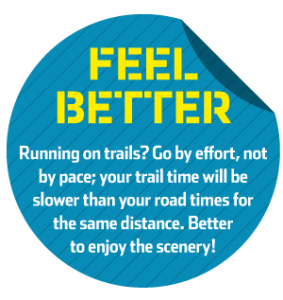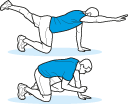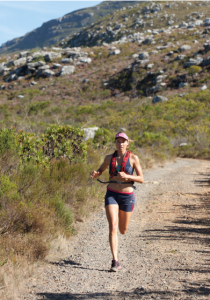Ease the load
By Bob Cooper
Running may be the quickest, the most invigorating, and (for many) the most enjoyable way to get and stay fit. So it’s doubly frustrating when you’re sidelined by aches, pains, or worse, injuries.
Easing up – on surfaces, strides, and kilometres – can help you stay healthy. “Your body absorbs about three times your weight with each step that you run,” says Dr Bert Fields, a five-decade runner who heads a university sports medicine fellowship programme.
“So the most effective way to cut back on injuries may be to cut back on the pounding.”
Here’s how:

Whether softer running surfaces are less injurious – and by how much – is debated among sports scientists: the studies are few, inconclusive, or conflicting. Complicating matters is that the answers may depend partly on your stride, foot type, weight, weekly mileage, injury history, footwear selection, and so on. Still, many coaches and elite runners believe that soft surfaces rule. For decades, elites have favoured running as much as possible on dirt, grass, and sand, rather than tar and concrete.
“Up to half of my mileage is off-pavement, on a variety of trails, and grass fields,” says Lauren Fleshman, a 5 000-metre track star and marathoner. “There’s a noticeable difference in the amount of shock I feel on trails compared to the roads, especially in my quads and feet.” Fleshman says this lets her recover faster. Besides the advantages of a softer surface, trails are on varied terrain, which makes you change your stride length and direction constantly, says Erika Lindland, a doctor and physical therapist. “These changes in muscle-use patterns reduce stress on muscle and connective tissue,” Lindland says, “which allows for better recovery and less injury risk.”
That doesn’t mean you should go out right now and run on nothing but trails. If you’ve been running only on roads, you should adapt gradually, with a few off-road kilometres each week. The uneven surfaces will vary the stresses on your feet and body, challenge you more, and let you recover faster between runs. If you have poor balance or are prone to ankle twists or Achilles injuries, avoid uneven, hazardous surfaces like rocky trails and spongy grass.
When you land hard on your feet, the impact radiates up through your muscles, ligaments, tendons, and connective tissue, from feet to hips. That takes a toll, sometimes leading to a breakdown on this kinetic chain. Smoothing out your stride can lessen the force of each landing, says Chris Johnson, a running coach and certified personal trainer.
Johnson encourages runners to consult a coach before overhauling form, but says there are a few minor adjustments that are safe and simple to try on your own. First, try pushing off your big toe, with the foot under or slightly behind your hips. “This disperses force more effectively throughout the lower body,” Johnson says. “Think of the push-off as a clawing motion, pulling the ground back as you launch forward.”
Another easy fix is to run with a slight forward lean. “Running with no lean forces you to land hard on your heels,” Johnson says. (A study published this year by the American College of Sports Medicine found that heel-strikers had about twice the repetitive stress injury rate of forefoot-strikers.) “But keep your torso straight, and don’t lean more than a few degrees forward or you’ll limit your ability to open up your stride.”
Swing your arms close to your sides, with hands between hips and chest. “Excessive arm swing results in hip and leg rotation that can cause overpronation,” he says, “and that concentrates too much ground-reaction force near the big toe.”
And on downhills, resist the temptation to lengthen your stride and ‘brake’ on your heels. “Run as if you’re pedalling a bike rather than drilling your heels into the ground,” he says, “and try to roll your feet from midfoot to forefoot.”
For those who love to run and only run, the sad truth is that more isn’t always better.
The only sure way to reduce your injury risk is to reduce your mileage, according to a 2010 review of running-injury studies.
“Higher mileage is the factor with the highest correlation to running-injury frequency,” says Fields. “It appears that most runners can safely build up to 65 kilometres a week, but unless they’re biomechanically perfect, the injury risk starts climbing when they go above that. That’s why so many coaches are replacing some mileage with cross-training.”
Non-impact activities like deep-water pool running, cycling, and elliptical-trainer workouts give you almost all of the benefits of replaced runs, from cardio fitness to burning kilojoules. Your running muscles are still used, though in a slightly different way, and you can even mimic a speed workout doing these workouts.
Low-impact activities like hill walking also take some of the ‘pound’ out. And whole-body activities like swimming and strength training make you all-round stronger. The best bonus of all? You’ll feel even fresher on the days you do run.
Do these exercises three times a week to ‘smooth’ your stride.
Stand on your right foot with the left foot a few centimetres above the floor. Slowly move your hips back while leaning forwards to touch left hand to right foot. Return to start; do 15 reps for each leg.
Why Improves hip and ankle stability, letting you land and push off the midfoot
more easily.

From your hands and knees, reach one arm forward and extend the opposing leg back. Touch that arm’s elbow to that leg’s knee. Release; do 15 reps for each leg.
Why Improves force transfer from your limbs to the torso, which
stabilises the pelvis.

Skip for 30 seconds at a quick tempo (land alternately on each foot between rope turns), rest 30 seconds, repeat five times.
Why? Improves strength in the ankles, the runner’s shock absorbers.
Source: http://www.runnersworld.co.za
previous link click ...[[back]] << top of the document >>
See also:
»Newer topics:
»Older topics:
»
![]() Stay on Course
Stay on Course
Common steps to keep healthy - in sports
![]() Stay on Course
Stay on Course
Common steps to keep healthy - in sports
See also:
»Newer topics:
»Older topics:
»
![]() Foam Rolling for Runners
Foam Rolling for Runners
foam-roller ---- deep-tissue-massage
![]() Foam Rolling for Runners
Foam Rolling for Runners
foam-roller ---- deep-tissue-massage
See also:
»Newer topics:
»Older topics:
»
![]() Up your immunity
Up your immunity
many runners report developing colds and other upper-respiratory infections in the two weeks following a race...
![]() Up your immunity
Up your immunity
many runners report developing colds and other upper-respiratory infections in the two weeks following a race...
See also:
»Newer topics:
»Older topics:
»
![]() Have a Cold? Rather Rest!
Have a Cold? Rather Rest!
Is running with a cold bad for you?
![]() Have a Cold? Rather Rest!
Have a Cold? Rather Rest!
Is running with a cold bad for you?





